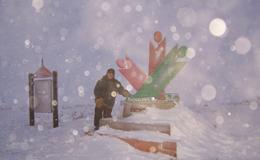ARTICLE 2 GRIEVING WELL: FACING DEATH
By: Terry Garchinski, Life Works Counselling and Training Services Inc.
Submitted to the Yellowknifer, Northern News Services Ltd., July 2, 2004, Yellowknife, Northwest Territories
When someone dies, we are left reaching out and that person is not there to reach back. Instead of shaking that person’s hand or hugging that person, there is no one there. There is no hand to shake. There is no body to hug. We are separated, disconnected, detached, apart. We are left hanging. We are left in emptiness. We are left with thoughts, feelings and experiences that hang in the air like broken telephone lines. Where once we were connected, now the connections are broken. We are alone.
The loss can be overwhelming. We can go into shock. Our thoughts can be confused and our emotions can be extreme or we could feel nothing at all.
In the short term, we might respond by being alone, pushing everyone else away, being angry with God, being angry at the world or particular people or situations, seeing the world as a scary, hurtful place. We might be very afraid of someone else close to us or ourselves dying. We might respond by drinking until we are drunk or pass out or black out. We might use drugs to push the hurt and pain down deep inside of us. We might gamble or do some other activity to distract us. We might blame, judge or fault others or ourselves.
But if we continue to do any of these things as a way of coping over a longer period of time, we are killing ourselves. We are dying inside. We are killing our bodies, our hearts, our minds and our spirits. This is not grieving in a healthy way. This is running away from our own responsibilities to ourselves, our families and our community.
To grieve in a healthy way is to face death and to sort out our own loose ends.
To grieve in a healthy way is to make sense of the death. To the best our ability create the story of life and death, describe what happened, how did the person die? What was going on before, during and after the person’s death?
To grieve in a healthy way is to sort out our thoughts. What was my first thought when I learned that the person had died? What did I think about the circumstances of the death? What do I think about the inevitability of my own death or the death of those I love the most?
To grieve in a healthy way is to sort out our feelings. What did I first feel when I learned that the person had died? What did I feel the next day? What did I feel when I saw the body? What did I feel at the funeral? What is my anger telling me? What is my fear telling me? What is my sadness telling me? What else am I feeling? How do I respond to these feelings?
To grieve in a healthy way is to reconnect with oneself, to reconnect with the person who had died on a spiritual level through ceremonies, memories, songs and stories about the person. To grieve in a healthy way is to reconnect with the land. There is a bigger picture. There is a higher power. To regain balance in our life again we need to connect with the Creator: the One who gives, maintains and takes away all life.
Healthy grieving happens over time. We make choices and we follow through with action. Ultimately, each person is responsible for his or her own grieving but we don’t have to do it alone. It is more effective to grieve with others: within the relationships of friends; family and our community.
The choices and actions that can aid us to grieve in a healthy way are unique to each person. Because our relationship with the deceased person is unique, therefore, our grief will also be unique. We need to grieve in our own way – in a way that is beneficial for us to accept the reality of the changes that death brings. A way to help us to move to the new reality: life without the deceased person. These are some things that may be helpful:
- Participate in a wake and a funeral;
- Pray (in your own way with sage, sweat grass or a Rosary);
- Cry;
- Talk to an elder, counsellor, spiritual leader;
- Participate in ceremonies (Feed the Fire Ceremony);
- Sit with a medicine person;
- Go out on the land (hunting caribou, fishing, having a picnic);
- Tell stories to friends and family about the person who died;
- Participate in a Sweat;
- Visit the grave site and talk to the person who has died;
- Set a plate for the deceased person on special occasions (birthdays, Christmas, Easter, anniversaries);
- Participate in a feast;
- Write in a journal;
- Write a letter to the deceased person, say all the things you want to say, and then send it to the person by burning it in a fire.
Grieving well is to experience and make sense of these broken connections, and to reconnect the loose ends that the death has left with us.
If we grieve well, we can better appreciate our own life and the lives of all living things. Grieving well invites us to walk with respect, honour and love. Grieving well invites us not to put our own hurt and pain on ourselves or on other people, but to use it as an opportunity to live more deeply with greater awareness. To grieve well is to live well.

